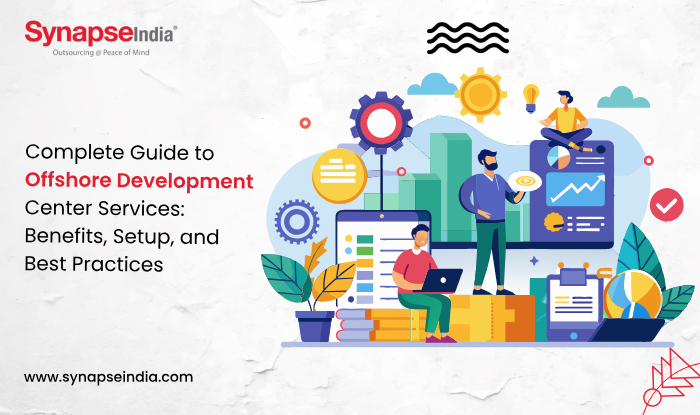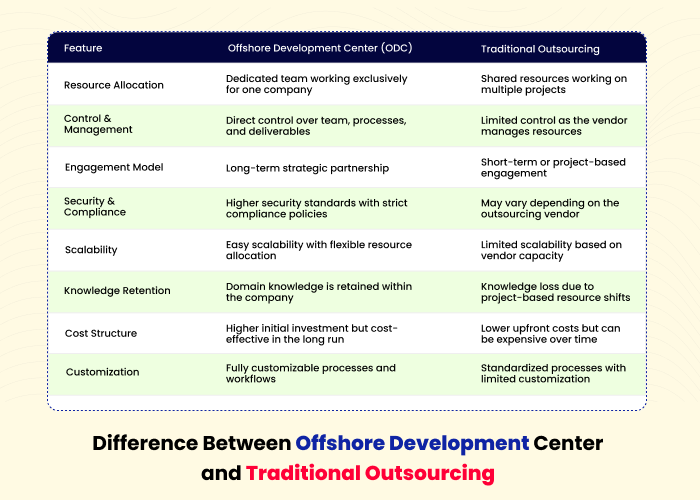 02 Nov 2024
02 Nov 2024
Relying on offshore development center services, businesses can seamlessly extend their developmental capabilities. This provides an alternative to hiring an in-house team which not only proves to be convenient but is cost-effective as well.
Hiring experts, building appropriate infrastructure, and scaling resources for separate projects can be a very challenging affair. As a business that deals with different technologies, establishing and managing an in-house dedicated team for each can be expensive as well. In such cases, offshore development center services come to the rescue. Basically, an offshore development center is a dedicated facility set up in a different country where labor is talented yet affordable. For businesses looking to enhance their operational capabilities while minimizing costs, these services are an ideal option.

An Offshore Development Center refers to a company’s extended branch that operates in different, mainly cheaper, countries. Organizations can hire local talents remotely while still maintaining complete control over projects and processes. ODCs typically focus on services like software development, quality assurance, and product engineering.
In today's globalized economy, the demand for faster, more efficient, and cost-effective solutions is paramount. Companies are increasingly choosing offshore development to access specialized skills, reduce operational costs, and enhance productivity. As technology advances, the gap between companies and their offshore partners is narrowing, making collaboration smoother and more effective. This trend aligns with the need for agility in product development, allowing businesses to remain competitive and responsive to market changes.
Many people often confuse offshore development services with outsourcing services. They might sound similar in context, but in reality, ODC differs in different parameters from outsourcing. Unlike traditional outsourcing, which often involves project-based contracts with external vendors, ODCs provide dedicated resources that align more closely with the culture and operational goals of the parent company. It offers significant advantages like:
As the popularity of offshore development centers is increasing, more and more industries are integrating this service into their operations. Check out some of the prominent industries that are successfully using ODCs to carry out different functions.

Offshore Development Centers (ODCs) are ideal for companies looking for long-term partnerships, greater control, and dedicated teams, while traditional outsourcing is better suited for short-term or cost-driven projects.
Offshore Development Centers provide a compelling value proposition for companies looking to innovate and grow while managing costs. As businesses face increasing pressures to deliver high-quality products quickly, ODCs offer several key advantages.
One of the primary reasons companies choose ODCs is the significant reduction in operational and labor costs. By establishing a center in a country with a lower cost of living, businesses can save on salaries, overhead, and infrastructure expenses. This financial benefit allows companies to allocate more resources to research, development, and marketing efforts, ultimately leading to higher profitability.
ODCs enable companies to tap into a diverse talent pool of skilled professionals across the globe. This access to various expertise allows organizations to find the right talent for their specific needs, whether that be software development, data science, or UX design. This global hiring strategy not only enhances the quality of work but also brings fresh perspectives and innovative ideas to projects.
Operating in multiple time zones allows ODCs to create a round-the-clock workflow, significantly increasing productivity. As one team completes its workday, another can begin, facilitating continuous project development. This model enables companies to accelerate their time to market, responding swiftly to customer demands and market changes.
Offshore Development Centers offer businesses the flexibility to scale their teams quickly based on project demands. Whether launching a new product, handling seasonal workload spikes, or embarking on a long-term project, ODCs provide the agility needed to respond effectively without the delays associated with traditional hiring processes. Companies can quickly adjust team sizes to meet specific requirements, ensuring they remain competitive in an ever-changing landscape.
Offshore Development Centers offer a wide range of services designed to meet the diverse needs of businesses. These services help organizations optimize their operations and focus on their core competencies.
One of the primary functions of ODCs is to provide software development services tailored to the needs of the parent company. This can range from web and mobile application development to complex software solutions. By leveraging the expertise of local developers, companies can ensure high-quality deliverables that align with their business objectives.
ODCs can also provide essential data management services. These include data analytics, database management, data security, and others, all of which are crucial for maintaining smooth operations and making informed business decisions. By outsourcing these functions to an ODC, companies can improve efficiency and focus on strategic initiatives.
In industries such as manufacturing and technology, ODCs can play a critical role in product engineering. They assist in the design, development, and testing of new products, ensuring that they meet market requirements and adhere to quality standards. This capability enables companies to bring innovative products to market more efficiently.
Quality assurance is vital for any software or product development process. ODCs provide comprehensive testing and quality assurance services to ensure that products meet quality standards before they are launched. This helps prevent costly post-launch issues and enhances customer satisfaction.
With the increasing reliance on cloud technologies, ODCs can offer cloud management and infrastructure services. These include setting up and managing cloud environments, ensuring data security, and optimizing infrastructure for better performance. This would allow companies to leverage advanced technologies without requiring a significant investment.
Establishing an ODC involves several critical steps. This process requires careful planning and execution to ensure the ODC aligns with the company’s strategic goals.
Before setting up an ODC, it is crucial to define the objectives and scope of the project. Companies should determine what functions the ODC will serve, whether it’s software development, product engineering, or any other task. Clearly outlining goals and expectations will guide the entire set-up process and ensure alignment with the parent company’s objectives.
Selecting the right location for an ODC is a pivotal decision. Companies should consider various factors:
Once the location is determined, the next step is to create an onboarding and integration plan. This plan should focus on ensuring that the ODC staff understands the parent company's culture, processes, and expectations. A well-structured onboarding process facilitates a smooth transition and fosters collaboration between teams.
An effective ODC requires a robust infrastructure and technology setup. This includes high-speed internet access, secure network configurations, and remote access tools to facilitate collaboration. Investing in reliable technology ensures that teams can work efficiently and communicate seamlessly, regardless of their physical location.
Navigating legal and compliance issues is essential when setting up an ODC. Companies must consider various factors, including:
Hiring skilled professionals is critical to the success of an ODC. Companies should focus on finding candidates who not only possess the necessary technical skills but also fit the organizational culture. This may involve utilizing local recruitment agencies or leveraging online job platforms to reach a broader audience.
Effective management and communication processes are vital for the success of an ODC. Companies should implement project management tools, such as Jira or Trello, to track progress and facilitate collaboration. Regular meetings and updates are essential to maintain transparency and keep teams aligned with project goals.
To measure the success of an ODC, it’s important to establish clear key performance indicators (KPIs) and metrics. These may include project completion rates, quality of deliverables, team productivity, and overall cost savings. Regularly reviewing these metrics will help organizations assess the effectiveness of the ODC and make necessary adjustments.
.png)
Offshore Development Centers (ODCs) offer cost savings and access to global talent, yet they come with distinct challenges.
Time Zone Differences: Time zone differences can disrupt real-time collaboration, causing delays in communication and project updates. To mitigate this challenge, establish clear communication protocols, leverage project management tools for task tracking, and schedule regular stand-up meetings. Utilizing overlapping work hours and asynchronous updates can help synchronize efforts and ensure smooth workflow across time zones.
Cultural Barriers : Language and cultural differences can create misunderstandings, impacting project requirements, team dynamics, and overall collaboration. To address this, promote cultural awareness through training programs, encourage open communication, and provide language support for both offshore and onshore teams. Fostering mutual respect and understanding enhances teamwork, reduces miscommunication, and improves project outcomes.
Data Security Risks : Security concerns become more critical when offshore teams handle sensitive data, requiring stringent measures to prevent breaches. Strengthening security involves implementing robust data protection policies, conducting regular audits, enforcing strict access controls, and ensuring compliance with international standards. Employee training on cybersecurity best practices further enhances data integrity and confidentiality.
Retention of Talent : Retaining talent in offshore teams is crucial for maintaining project stability and efficiency. To enhance retention, offer competitive compensation, career growth opportunities, and a positive work environment. Regular engagement, recognition programs, and skill development initiatives help boost employee satisfaction, fostering loyalty and reducing turnover within the offshore workforce.
The rise of AI, cloud computing, and automation is reshaping ODCs, enabling cost efficiency and innovation. By 2025, 85% of enterprises will adopt a cloud-first strategy, fueling demand for ODCs. The AI market in the USA is expected to reach over $66 billion by 2025, further driving offshore collaboration in AI-driven solutions. The USA remains a hotspot for Offshore Development Centers (ODCs) due to its advanced infrastructure, skilled workforce, and tech-driven economy. Additionally, its strong IP protection laws and access to global talent make it an attractive destination for companies looking to establish and expand their ODCs.
AI and Automation Integration
ODCs are leveraging AI and automation to enhance software development, optimize workflows, and reduce operational costs, driving innovation and improving efficiency in software engineering projects.
Cloud-First Adoption
With the majority of enterprises adopting a cloud-first strategy, ODCs will play a crucial role in supporting cloud migration, infrastructure management, and software-as-a-service (SaaS) development for businesses.
Strong IP and Data Security Laws
The USA’s robust intellectual property and data security regulations make it an attractive location for ODCs, ensuring compliance and safeguarding businesses from cybersecurity threats and data breaches.
Access to a Global Talent Pool
The USA offers a diverse, highly skilled workforce, allowing ODCs to collaborate with top-tier developers, engineers, and data scientists, fostering innovation and technological advancements.
Expansion of Hybrid Work Models
The shift towards hybrid and remote work is enabling ODCs to operate efficiently across borders, integrating offshore teams seamlessly while ensuring flexibility and productivity in software development projects.
Successfully managing an Offshore Development Center requires strategic oversight and continuous improvement. Implementing the following best practices can enhance collaboration and ensure the ODC meets its objectives.
Creating a cohesive company culture that bridges the gap between the parent company and the ODC is essential. Regular team-building activities, virtual social events, and cross-training opportunities can help foster a sense of belonging and strengthen relationships among team members.
By implementing agile practices, companies can ensure that their ODC teams can respond quickly to changes in project requirements or market conditions, enhancing overall productivity.
Frequent performance reviews provide insights into team effectiveness and project progress. Companies should schedule regular check-ins and performance assessments to identify areas for improvement and recognize achievements. This continuous feedback loop can help maintain high standards and motivate teams.
Effective communication is the backbone of successful ODC operations. Companies should establish clear communication channels, utilize collaboration tools, and encourage open dialogue between teams. This transparency ensures that everyone is aligned on project goals and expectations.
Encouraging ongoing training and development is essential for maintaining a competitive edge. Companies should invest in upskilling their ODC teams by providing access to training programs, workshops, and resources. This investment enhances team capabilities and fosters employee satisfaction and retention.
The business landscape is constantly evolving, and companies must stay informed about market trends and technological advancements. Regularly monitoring these changes allows organizations to adapt their ODC strategies, ensuring they remain competitive and responsive to customer needs.
| Aspect | Offshore Development Center (ODC) | In-House Development |
|---|---|---|
| Cost | Lower due to reduced labor and operational costs | Higher costs for salaries, infrastructure, and benefits |
| Control | Less direct oversight; depends on remote management tools | Higher control over team and processes |
| Talent Pool | Access to global talent, offering diverse expertise | Limited to local talent or relocation |
| Security | Requires strict data protection and compliance measures | Easier to secure data within controlled internal systems |
| Cultural Differences | Can lead to communication challenges and misunderstandings | Generally aligned with organizational culture |
| Flexibility | Flexible scaling of teams based on project needs | Scaling may require longer recruitment and training periods |
| Infrastructure | Typically managed by the offshore partner, reducing operational load | Requires investment in office space, equipment, and utilities |
| Innovation | Diverse perspectives may bring fresh ideas | Stronger alignment with the company vision and immediate feedback |
| Team Cohesion | May face challenges due to physical and cultural separation | Easier to build cohesive, collaborative teams |

Establishing an Offshore Development Center provides long-term benefits, including cost savings, dedicated talent retention, enhanced security, and seamless scalability. It fosters continuous innovation, ensures better control over operations, and enables domain knowledge retention. A well-managed ODC strengthens collaboration, accelerates project delivery, and drives sustained business growth in global markets.
Offshore Development Centers offer services like software development, cloud solutions, AI and automation, cybersecurity, QA testing, and product engineering. They also provide data analytics, UI/UX design, DevOps, and ongoing maintenance. ODCs enable businesses to scale efficiently while ensuring high-quality, cost-effective, and secure technology solutions.
An Offshore Development Center enhances scalability by providing a flexible workforce that can quickly adapt to project demands. It allows businesses to scale teams up or down efficiently, access specialized talent, and optimize costs. ODCs ensure seamless expansion, supporting innovation and agility while maintaining operational efficiency and quality.
An Offshore Development Center in the USA offers dedicated teams, direct control, and long-term collaboration, unlike traditional outsourcing, which relies on shared resources and vendor management. ODCs ensure higher security, better compliance, and scalability, fostering innovation and efficiency while retaining domain knowledge for sustained business growth and competitiveness.
Industries like fintech, healthcare, e-commerce, manufacturing, and telecommunications benefit most from Offshore Development Centers. These sectors leverage ODCs for cost-effective software development, AI integration, cloud solutions, cybersecurity, and data analytics. ODCs enhance innovation, scalability, and efficiency, helping businesses stay competitive in rapidly evolving technological landscapes.
Offshore development centers offer strategic and economical solutions for companies to enhance their operational capabilities. By understanding the benefits, setting up an ODC effectively, and adhering to best practices, organizations can leverage the full potential of these centers. The future of business is increasingly global, and establishing a successful ODC can provide the agility and expertise needed to thrive in an ever-changing marketplace.

 12 Jun 2024
12 Jun 2024
